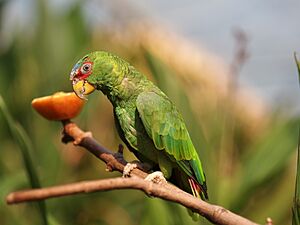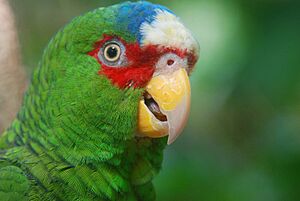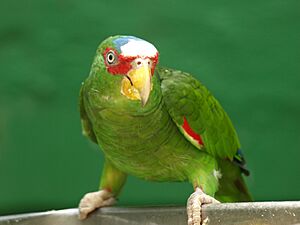White-fronted amazon facts for kids
Quick facts for kids White-fronted amazon |
|
|---|---|
 |
|
| Conservation status | |
| Scientific classification | |
| Genus: |
Amazona
|
| Species: |
albifrons
|
| Subspecies | |
|
A. a. albifrons |
|
 |
|
The white-fronted amazon (Amazona albifrons), also known as the white-fronted parrot, is a colorful bird from Central America. It's a type of parrot known for its ability to copy many different sounds. These amazing birds can learn to imitate 30 to 40 different noises! Like other big parrots, the white-fronted parrot can live a long time, often around 40 years.
Contents
What Does It Look Like?
The white-fronted amazon is the smallest of the amazon parrots. It is about 25 cm (9.8 in) long. This parrot gets its name from the bright white feathers on its forehead. The amount of white can be different for each bird.
Most of their feathers are green. They have some blue on their wings when they spread them out. You'll also see bright red around their eyes, almost like spectacles! Behind the white patch on their forehead, they have blue feathers.
It's easy to tell the difference between male and female white-fronted amazons. This is called sexual dimorphism. Male parrots have bright red feathers on their "shoulders" (called the alula). Female parrots have green "shoulders." Young parrots have light gray eyes. They also have less red on their face and a smaller yellowish area instead of white.
Types of White-Fronted Amazons
There are three main types, or subspecies, of the white-fronted amazon. They have small differences in their colors and size:
- White-fronted amazon (A. a. albifrons) — This type is found from western Mexico to southwestern Guatemala.
- Lesser white-fronted amazon (A. a. nana) — You can find this type from southeastern Mexico to northwestern Costa Rica.
- Sonora white-fronted amazon (A. a. saltuensis) — This type lives in northwestern Mexico.
Where Do They Live?
The white-fronted amazon lives in Central America and Mexico. You will often see them in small groups, called flocks, of up to 20 birds. They live in many different places. This includes wet areas like rainforests and drier spots like cactus savannahs.
In the wild, these parrots are not shy. People can often get quite close to them. Sometimes, many flocks gather together. People have seen groups with hundreds of birds! These large groups might even include other types of parrots, like the red-lored amazon.
Some white-fronted amazons have been seen in southern Texas. These are probably birds that escaped from captivity. A small group of wild parrots has also been seen living in southern California. There are also reports of them breeding in Puerto Rico.
Reproduction and Life Cycle
White-fronted amazons make their nests in holes inside trees. Their breeding season usually starts in the spring, around February. It ends in the summer, often in June and July.
After breeding, the female parrot usually lays about three to four white eggs. The eggs are kept warm for about 26 days. This is called incubation. The baby parrots, called chicks, leave the nest when they are about 60 days old.
White-Fronted Amazons as Pets
Sometimes, people keep white-fronted amazons as pets or in aviaries (large bird enclosures). When they are tamed, they are usually friendly, loving, playful, and smart birds. They can learn to talk and often become very close with their owners.
Like many parrots, they can live a very long time. In captivity, they might live for over 50 years! However, they are also very loud and noisy birds. This means they are not a good choice for living in an apartment. They need lots of exercise, chances to play, and social time to be happy and healthy. The World Parrot Trust suggests that these parrots should live in an enclosure that is at least 3 meters (about 10 feet) long.
Gallery







